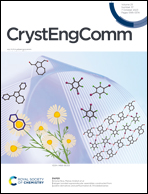Flexible self-powered solar-blind Schottky photodetectors based on individual Ga2O3 microwire/MXene junctions†
Abstract
Solar-blind photodetectors that are exclusively sensitive to deep ultraviolet light have garnered increasing interest due to their numerous applications. In this work, flexible solar-blind Schottky photodetectors made of individual Ga2O3 microwires and MXene on a flexible polyethylene terephthalate substrate are reported. The Ga2O3 microwire/MXene photodetector has an ultralow dark current (10−13–10−12 pA), a responsivity of 0.25 mA W−1 and a detectivity of 4 × 109 Jones under the illumination of 254 nm light with a power intensity of 0.11 mW cm−2 at zero bias. The photodetector also exhibits a fast rise/decay time (162 μs/35.8 ms), which is superior to those of most reported flexible Ga2O3 photodetectors. The favorable photoelectric properties of the Ga2O3 microwire/MXene photodetectors are attributed to the high crystal quality of Ga2O3 microwires and the large Schottky barrier (∼1.34 eV) between the Ga2O3 microwires and MXene. Additionally, without any encapsulation, the photodetectors exhibit exceptional mechanical flexibility as well as long-term environmental stability. The facile and efficient fabrication method of the Ga2O3 microwire/MXene photodetectors makes them ideal for low-cost and flexible solar-blind photodetection.



 Please wait while we load your content...
Please wait while we load your content...